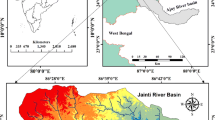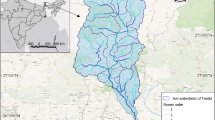Abstract
Soil erosion is a major consequence which usually reduces soil productivity. The identification of its susceptible zones is essential in order to apply preventive measures in any basin. A detailed morphometric evaluation of Ami river basin is done using Shuttle Radar Topography Mission (SRTM) data of 30m resolution. Technique for order of preference by similarity to ideal solution (TOPSIS) and analytic hierarchy process (AHP) based prioritization and characterization of sub-watersheds is important to plan and manage the natural resources of a region. Total 18 sub-watersheds with an outlet having 4th order drainage were selected for the prioritization purpose for soil erosion susceptibility zones with the help of 10 morphometric parameters. The sub-watersheds were ordered from SW-I to SW-XVIII. In this regard, SW-XV has the highest priority (0.628) and higher soil erosion while SW-XVIII (0.317) has lowest conditions for soil erosion.
Various tectonic and sinuosity related parameters are calculated and analyzed like hypsometric integral (0.49), asymmetric factor (50.1) and transverse topographic symmetric factor suggesting good symmetry of basin with no tectonic tilt. The value of standard sinuosity index (1.2) suggests that Ami river is naturally sinuous stream. Morphometric parameters suggest less structurally controlled and normal category of the basin. The basin has coarse texture of drainage with highly suspect to soil erosion and high run off.
Similar content being viewed by others
References
Alexakis, D.D., Hadjimitsis, D.G. and Agapiou, A. (2013) Integrated use of remote sensing, GIS and precipitation data for the assessment of soil erosion rate in the catchment area of “Yialias” in Cyprus. Atmospheric Res., v.131, pp.108–124.
Ameri, A.A., Pourghasemi, H.R. and Cerda, A. (2018) Erodibility prioritization of sub-watersheds using morphometric parameters analysis and its mapping: A comparison among TOPSIS, VIKOR, SAW, and CF multi-criteria decision making models. Sci. Total Environ., v.613, pp.1385–1400.
Amiri, M., Pourghasemi, H. R., Arabameri, A., Vazirzadeh, A., Yousefi, H., and Kafaei, S. (2019) Prioritization of flood inundation of Maharloo Watershed in iran using morphometric parameters analysis and TOPSIS MCDM model. In: Spatial modeling in GIS and R for Earth and Environmental Sciences, pp. 371–390.
Avinash, K., Jayappa, K.S. and Deepika, B. (2011) Prioritization of sub-basins based on geomorphology and morphometric analysis using remote sensing and geographic information system (GIS) techniques. Geocarto Internat., v.26(7), pp.569–592.
Bhat, F.A., Bhat, I.M., Sana, H., Iqbal, M. and Mir, A. R. (2013) Identification of geomorphic signatures of active tectonics in the West Lidder Watershed, Kashmir Himalayas: Using Remote Sensing and GIS. Internat. Jour. Geomat. Geosci., v.4(1), 164–176.
Bhatt, S.C., Hussain, A.S.M. and Balasooriya, N.W.B. (2017) Geological structure control on Sukhnai Basin and Land Use/Land Cover Pattern in Mauranipur and adjoining areas, Bundelkhand Craton, Central India. Jour. Geol. Soc. Sri Lanka, v.18(2), pp.53–61.
Bhatt, S.C., Suresh, M. and Gupta M. K. (2014) Structural Control on Drainage Pattern of Upper-Middle Pahuj River Basin and Implication of Remote Sensing in Watershed Management, Bundelkhand Craton, Central India, Jour. Multidisciplinary Scient. Res., v.2(4), pp.09–14.
Burrard, S.S. (1912) On the Origin of the Himalayan Mountain, Geological Survey of India. Professional Paper No. 12, 11.
Chan, F.T. and Kumar, N. (2007) Global supplier development considering risk factors using fuzzy extended AHP-based approach. Omega, v.35(4), pp.417–431.
Chopra, R., Dhiman, R. D. and Sharma, P. K. (2005) Morphometric analysis of sub-watersheds in Gurdaspur district, Punjab using remote sensing and GIS techniques. Jour. Indian Soc. Remote Sens., v.33(4), pp.531.
Choudhari, P.P., Nigam, G.K., Singh, S.K. and Thakur, S. (2018) Morphometric based prioritization of watershed for groundwater potential of Mula river basin, Maharashtra, India. Geol., Ecol. Landscapes, v.2(4), pp.256–267.
Cox, R.T. (1994) Analysis of drainage-basin symmetry as a rapid technique to identify areas of possible Quaternary tilt-block tectonics: An example from the Mississippi Embayment. Geol. Soc. Amer. Bull., v.106(5), pp.571–581.
Cox, R. T., Van Arsdale, R. B., and Harris, J. B. (2001) Identification of possible Quaternary deformation in the northeastern Mississippi Embayment using quantitative geomorphic analysis of drainage-basin asymmetry. Geol. Soc. Amer. Bull., v.113(5), pp.615–624.
Das, S. (2020) Koyna-Warna Shallow Seismic Region, India: Is there Any Geomorphic Expression of Active Tectonics? Jour. Geol. Soc. India, v.96(3), pp.217–231.
Diakakis, M. (2011) A method for flood hazard mapping based on basin morphometry: application in two catchments in Greece. Natural Hazards, v.56(3), pp.803–814.
El Hamdouni, R., Irigaray, C., Fernández, T., Chacón, J. and Keller, E. A. (2008) Assessment of relative active tectonics, southwest border of the Sierra Nevada (southern Spain). Geomorphology, v.96(1–2), pp.150–173.
Faniran, A. (1968) The index of drainage intensity—a provisional new drainage factor. Australian Jour. Sci., v.31, pp.328–330.
Flores-Prieto, E., Quénéhervé, G, Bachofer, F., Shahzad, F., and Maerker, M. (2015) Morphotectonic interpretation of the Makuyuni catchment in Northern Tanzania using DEM and SAR data. Geomorphology, v.248, pp.427–439.
Gravelius, H. (1914) Morphometry of Drainage Bassins. In.: Amsterdan: Elsevier.
Hack, J.T. (1973) Stream-profile analysis and stream-gradient index. Jour. Res. USGS, v. 1(4), pp.421–429.
Hajam, R.A., Hamid, A. and Bhat, S. (2013) Application of morphometric analysis for geo-hydrological studies using geo-spatial technology-a case study of Vishav Drainage Basin. Hydrol. Curr. Res., v.4(3), pp.1–12.
Holbrook, J. and Schumm, S.A. (1999) Geomorphic and sedimentary response of rivers to tectonic deformation: a brief review and critique of a tool for recognizing subtle epeirogenic deformation in modern and ancient settings. Tectonophysics, v.305(1–3), pp.287–306.
Horton, R.E. (1932) Drainage basin characteristics. Eos, Trans. Amer. Geophys. Union, v.13(1), pp.350–361.
Horton, R.E. (1945) Erosional Development of streams and their drainage basins; Hydrophysical approach to quantitative morphology. Geol. Soc. Amer. Bull., v.56, pp.275–370.
Hwang, C.L. and Yoon, K. (1981) Multiple Attributes Decision Making Methods and Applications. Springer, Berlin Heidelberg, p.225
Jozaghi, A., Alizadeh, B., Hatami, M., Flood, I., Khorrami, M., Khodaei, N. and Ghasemi Tousi, E. (2018) A comparative study of the AHP and TOPSIS techniques for dam site selection using GIS: a case study of Sistan and Baluchestan Province, Iran. Geosciences, v.8(12), pp.1–23.
Kale, V.S. and Shejwalkar, N. (2008) Uplift along the western margin of the Deccan Basalt Province: Is there any geomorphometric evidence?. Jour. Earth System Sci., v.117(6), pp.959–971.
Kandregula, R.S., Kothyari, G.C., Swamy, K.V. and Rawat, S. (2019). Quantitative assessment of tectonic activity in Northern Saurashtra, Western India. Jour. Indian Geophys. Union, v.23(6), pp.542–558.
Kothyari, G.C., Joshi, N., Taloor, A.K., Kandregula, R.S., Kotlia, B.S., Pant, C.C. and Singh, R.K. (2019). Landscape evolution and deduction of surface deformation in the Soan Dun, NW Himalaya, India. Quaternary Internat., v.507, pp.302–323.
Kothyari, G.C., Shukla, A.D. and Juyal, N. (2017) Reconstruction of Late Quaternary climate and seismicity using fluvial landforms in Pindar River valley, Central Himalaya, Uttarakhand, India. Quaternary Internat., v.443, pp.248–264.
Krishnan, M.S. (2017) Geology of India and Burma, 6th Edition, CBS Publishers and Distributors, p.536.
Kumar, B. A. (2009) Studies on river sinuosity of Meenachil river with special reference to its palaeo channels using remote sensing. P.hd. thesis submitted to Mahatma Gandhi University [accessed on April 2020].
Kumar, N. and Singh, S.K. (2021) Soil erosion assessment using earth observation data in a trans-boundary river basin. Natural Hazards, v.107(1), pp.1–34.
Marple, R.T. and Talwani, P. (1993) Evidence of possible tectonic upwarping along the South Carolina coastal plain from an examination of river morphology and elevation data. Geology, v.21(7), pp.651–654.
Masselink, R.J., Heckmann, T., Temme, A.J., Anders, N.S., Gooren, H.P. and Keesstra, S.D. (2017) A network theory approach for a better understanding of overland flow connectivity. Hydrol. Processes, v.31(1), pp.207–220.
Melton, M.A. (1958) Correlation structure of morphometric properties of drainage systems and their controlling agents. Jour. Geol., v.66(4), pp.442–460.
Melton, M.A. (1965) The geomorphic and paleoclimatic significance of alluvial deposits in southern Arizona. Jour. Geol., v.73(1), pp.1–38.
Miller, V.C. (1953) Quantitative geomorphic study of drainage basin characteristics in the Clinch Mountain area, Virginia and Tennessee. Technical report (Columbia University. Department of Geology); no. 3.
Morisawa, M. (1957) Accuracy of determination of stream lengths from topographic maps. Eos, Trans. Amer. Geophys. Union, v.38(1), pp.86–88.
Nag, S.K. (1998) Morphometric analysis using remote sensing techniques in the Chaka sub-basin, Purulia district, West Bengal. Jour. Indian Soc. Remote Sens., v.26(1–2), pp.69–76.
Nag, S.K. and Chakraborty, S. (2003) Influence of rock types and structures in the development of drainage network in hard rock area. Jour. Indian Soc. Remote Sens., v.31(1), pp.25–35.
Olson, D.L. (2004) Comparison of weights in TOPSIS models. Mathematical and Computer Modelling, v.40(7–8), pp.721–727.
Ouchi, S. (1985) Response of alluvial rivers to slow active tectonic movement. Geol. Soc. Amer. Bull., v.96(4), pp.504–515.
Pareta, K. and Pareta, U. (2011) Quantitative morphometric analysis of a watershed of Yamuna basin, India using ASTER (DEM) data and GIS. Internat. Jour. Geomat. Geosci., v.2(1), pp.248–269.
Patton, P. C., and Baker, V. R. (1976) Morphometry and floods in small drainage basins subject to diverse hydrogeomorphic controls. Water Resour. Res., v.12(5), pp.941–952.
Pérez Peña, J.V., Azañón, J.M., Azor, A., Delgado, J. and González Lodeiro, F. (2009) Spatial analysis of stream power using GIS: SLk anomaly maps. Earth Surface Processes and Landforms, v.34(1), pp.16–25.
Pike, R.J. and Wilson, S.E. (1971). Elevation-relief ratio, hypsometric integral, and geomorphic area-altitude analysis. Geol. Soc. Amer. Bull., v.82(4), pp.1079–1084.
Pinter, N. and Keller, E.A. (2002) Active Tectonics: Earthquakes, Uplift, and Landscape. Prentice Hall, 362p.
Pishyar, S., Khosravi, H., Tavili, A., Malekian, A., & Sabourirad, S. (2020) A Combined AHP-and TOPSIS-Based Approach in the Assessment of Desertification Disaster Risk. Environmental Modeling and Assessment, v.25(2), pp.219–229.
Radhakrishna, B.P. (1992) Cauvery: its geological past. Jour. Geol. Soc. India, v.40(1), pp.1–12.
Rai, P.K., Mohan, K., Mishra, S., Ahmad, A. and Mishra V.N. (2014) A GIS-based approach in drainage morphometric analysis of Kanhar River Basin, India. Applied Water Sci., v.7(1), pp.217–232.
Romshoo, S.A., Bhat, S.A. and Rashid, I. (2012) Geoinformatics for assessing the morphometric control on hydrological response at watershed scale in the Upper Indus Basin. Jour. Earth System Sci., v. 121(3), pp.659–686.
Saaty, T.L. (1988) The analytic hierarchy process. New York: McGraw Hill Company, 350p.
Schumm, S.A. (1956) Evolution of drainage systems and slopes in badlands at Perth Amboy, New Jersey. Geol. Soc. Amer. Bull., v.67(5), pp.597–646.
Sinha-Roy, S. (2001) Neotectonically controlled catchment capture: An example from the Banas and Chambal drainage basins, Rajasthan. Curr. Sci., v.80(2), pp.293–298.
Strahler, A. N. (1952) Hypsometric (area-altitude) analysis of erosional topography. Geol. Soc. Amer. Bull., v.63(11), pp.1117–1142.
Strahler, A.N. (1957) Quantitative analysis of watershed geomorphology. Eos, Trans. Amer. Geophys. Union, v.38(6), pp.913–920.
Strahler, A.N. (1964) Part II. Quantitative geomorphology of drainage basins and channel networks. Handbook of Applied Hydrology. McGraw-Hill, New York, pp.4–39.
Varma, H., Sarup, J. and Mittal, S.K. (2020) Conception of Drainage Morphometry by using Remote Sensing and GIS. Internat. Jour. Emerging Tech., v.11(1), pp.72–77.
Vittala, S.S., Govindaiah, S. and Gowda, H.H. (2004) Morphometric analysis of sub-watersheds in the Pavagada area of Tumkur district, South India using remote sensing and GIS techniques. Jour. Indian Soc. Remote Sens., v.32(4), pp.351.
Yadav, S.K., Dubey, A., Szabo, S. and Singh, S.K. (2016) Prioritization of Sub-Watersheds based on Earth Observation Data of Agricultural Dominated Northern River Basin of India, Geocarto Internat., v.33(4), pp.1–38.
Yadav, S.K., Singh, S.K., Gupta, M. and Srivastava, P.K. (2014) Morphometric analysis of Upper Tons basin from Northern Foreland of Peninsular India using CARTOSAT satellite and GIS. Geocarto Internat., v.29(8), pp.895–914.
Yadav, S.K. and Singh, S.K. (2021) Morpho-tectonic assessment of Central Northern escarpment of Peninsular India, based on tectonically sensitive geomorphic indices. Physical Geograp., pp.1–31.
Zavoianu, I. (1985) Morphometry of Drainage Basins. Developments in Water Science, 20. Elsevier, Amsterdam, 238p.
Acknowledgement
First author would like to express his gratitude to the University Grants Commission (UGC), New Delhi, India for providing NET-JRF scholarship (UGC-Ref.No.:3331). Further, all the authors are grateful to the USGS for providing SRTM digital elevation data at no cost. The author Sudhir Kumar Singh thanks DST-FIST for providing support to our centre.
Author information
Authors and Affiliations
Corresponding author
Rights and permissions
About this article
Cite this article
Patel, A., Singh, M.M., Singh, S.K. et al. AHP and TOPSIS Based Sub-Watershed Prioritization and Tectonic Analysis of Ami River Basin, Uttar Pradesh. J Geol Soc India 98, 423–430 (2022). https://doi.org/10.1007/s12594-022-1995-0
Received:
Accepted:
Published:
Issue Date:
DOI: https://doi.org/10.1007/s12594-022-1995-0




